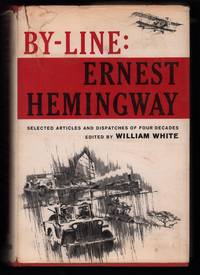 Hardback cover | |
| Author | Ernest Hemingway Edited by William White |
|---|---|
| Original title | By-Line: Ernest Hemingway Selected Articles and Dispatches of Four Decades 1920–1956 |
| Language | English |
| Genre | collection |
| Publisher | Charles Scribner's Sons |
Publication date | 1967 |
| Publication place | United States |
| Media type | Print (hardback) |
| Pages | 489 pp |
| OCLC | 284567 |
| 818/.5/208 | |
| LC Class | PS3515.E37 A6 1967 |
By-Line: Ernest Hemingway is a 1967 collection of 77 of the articles that Ernest Hemingway wrote as a journalist between 1920 and 1956. The collection was edited by William White, a professor of English literature and journalism at Wayne State University, and a regular contributor to The Hemingway Review . By-Line: Ernest Hemingway has been translated into fourteen languages and made The New York Times Best Seller list.